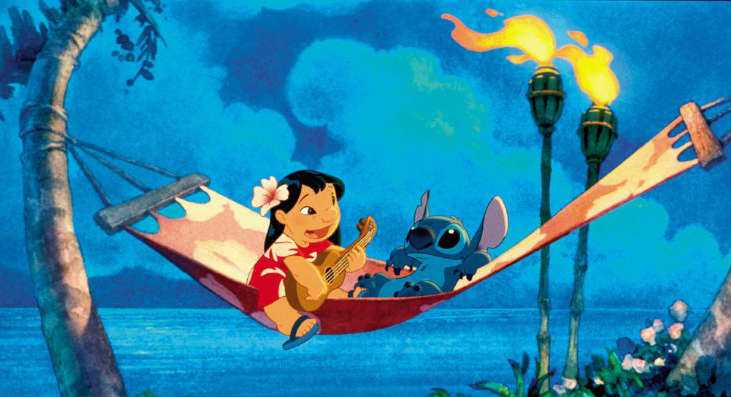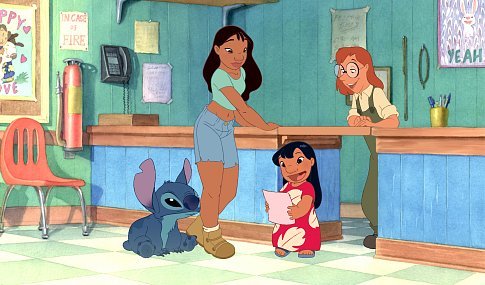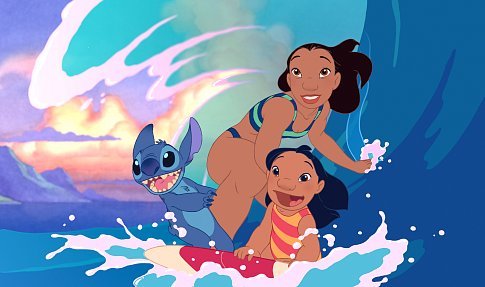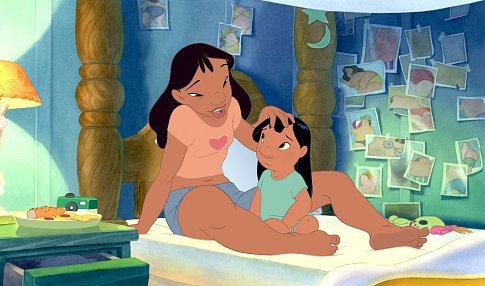
The animated films of Disney have an interesting history in terms of the representation of women. In the beginning, their female characters were passive, demur, only wanted to find love and waiting for a man to save them. When the Disney Renaissance came in 1989, female characters became much more proactive with wanting to achieve other goals, but still not quite realistic in terms of character designs and still wanting to find love. In 2002 Disney released, Lilo and Stitch, a film which proved Disney can get female characters right. I would like to share with you why I think Lilo and Stitch is such a feminist film.
The Variety of Women Represented

One great thing about the film, from a feminist perspective, is how many women are represented in the film and what their positions are. Two of the main protagonists are female, the person Lilo interacts with the most is female, and a number of background and minor characters are female. There is a montage near the middle of the film with the older sister Nani job hunting and Lilo trying to teach Stitch how to be a “model citizen” and it is this scene when we see women of different ages and positions. There are female shop owners, female pet shop workers, female dancers, female life guards, and even an elderly woman who owns vegetable and fruit stands. If that was not enough, the president of the entire galaxy is a female alien, with a feminine voice and being referred to with female pronouns. This may not seem that impressive on a surface level; but when one really thinks about it, there are very few animated films that have truly an equal representation of women, let alone more than half. This is just another impressive example of how this film stands out and how different it is then many of Disney’s other animated features.
Female Body Types

One of the most striking things about the film, especially for a Disney film, is the body types of the female characters and the representation of people of color. The shapes and sizes of bodies are more realistic and varied than most Disney films. Most female characters in past Disney films, specifically the princesses like Ariel and Jasmine, and even in recent films like Tangled and Frozen, have perfect hourglass shaped figures with huge, expressive eyes. It is understandable why this portrayal of one, perfect body image is a cause for concern with some parents. Such an image reinforces the idea to young girls that this kind of body is the only kind of body that is okay to have and should be idolized. In Lilo and Stitch, Nani is thin and in good shape, but her proportions are realistic. She has thick thighs and a real pelvis. This realistic look is not limited to Nani, but extended to other minor female characters like the animal humane society worker and the coffee shop owner. Lilo is a little chubby but this is not seen as a negative thing because this is what children look like. Several other children have similar body shapes to Lilo and then there are others who are little leaner.
One scene I have always liked is the scene of Lilo talking to Nani about the photos of overweight tourists on her wall and says: “My camera’s full again! Aren’t they beautiful?” I love how Lilo genuinely thinks people with such different looking bodies are still beautiful. Lilo’s view is one that positively promotes all kinds of body types and I adore her for it. The film represented people of color without making it the focus of the film, which seems to be the case with many other films that have people of color as their main characters. Lilo and Nani are undoubtedly of Hawaiian/Polynesian decent with darker skin and hair, but their story is one that several people can relate to. Moreover, there are numerous other people of different races and different ethnicities scattered throughout the film, which is also very accurate of Hawaii’s population.
Characterization and the Broken Family

Possibly some of the film’s greatest strengths are the characterizations of Lilo and Nani, their relationship and the representation of the broken family. Lilo is probably one of the best kid characters of all time and for Disney to accomplish that, is really saying something. Their past kid characters have ranged from okay to annoying, but Lilo is so far from that standard. Lilo is weird, violent, gets into fights, bizarre, emotional and quite creative. She even created her own special rag doll to play with named Scrump whose head is too big, so Lilo pretends a bug laid eggs in her ear. This is exactly how kids are and Lilo just happens to be even stranger than her peers, which makes her even more interesting. She deals with the struggles of being an outsider, which is something several kids in the audience can relate to. Lilo is also very imaginative and often creates fantasies to escape in order to deal with her loneliness and grief of losing her parents. For instance, every Thursday Lilo gives “Pudge the fish a peanut butter sandwich” because “Pudge controls the weather.”
In this film, there is no evil step-mother or bratty step-siblings. They are a broken family and the situation is very realistic. Lilo is in the care of her older sister Nani because their parents sadly passed away. However, the older sister has trouble looking out for her because she is constantly in between jobs in Hawaii’s depressed economy, has to look after a kid who is already a handful and on top of that Nani is the older sister; not the parent, so this is new and difficult territory for both of them. Nani, despite her overwhelming responsibilities, is still young herself. At times, she makes bad decisions and lets her anger get the better of her. Lilo and Nani’s relationship is also realistic. They fight and act like sisters, sometimes wanting to strangle each other. However, they are still family and they still love each other. The whole reason the sisters adopt Stitch in the first place is because Nani overhears Lilo wishing on a falling star that she wants a friend, “I need someone to be my friend. Someone who won’t run away. Maybe send me an angel! The nicest angel you have.” In addition, there is social worker known as Mr. Bubbles watching them, making sure Nani is a good parent, but he is not the bad guy. He is just doing his job and at times sees the tragedy of the situation. This is just a really bad turn of events that creates a really bad situation. It does not need a bad guy or a greedy villain. It is just life. And sometimes, that is all you need to tell a great story.
Lilo and Stitch is a film that does several things right with its female characters and female representation in general. Lilo and Stitch may not be one of Disney’s most popular works, but it is a work that deserves all the praise it can get. The film’s core message of the importance of family, as opposed to romantic love, is something that, hopefully, everyone can connect to.
What do you think about Lilo and Stitch? Do you agree? Sound off in the comments…
ARE YOU A ROMANCE FAN? FOLLOW THE SILVER PETTICOAT REVIEW:
 Our romance-themed entertainment site is on a mission to help you find the best period dramas, romance movies, TV shows, and books. Other topics include Jane Austen, Classic Hollywood, TV Couples, Fairy Tales, Romantic Living, Romanticism, and more. We’re damsels not in distress fighting for the all-new optimistic Romantic Revolution. Join us and subscribe. For more information, see our About, Old-Fashioned Romance 101, Modern Romanticism 101, and Romantic Living 101.
Our romance-themed entertainment site is on a mission to help you find the best period dramas, romance movies, TV shows, and books. Other topics include Jane Austen, Classic Hollywood, TV Couples, Fairy Tales, Romantic Living, Romanticism, and more. We’re damsels not in distress fighting for the all-new optimistic Romantic Revolution. Join us and subscribe. For more information, see our About, Old-Fashioned Romance 101, Modern Romanticism 101, and Romantic Living 101.
